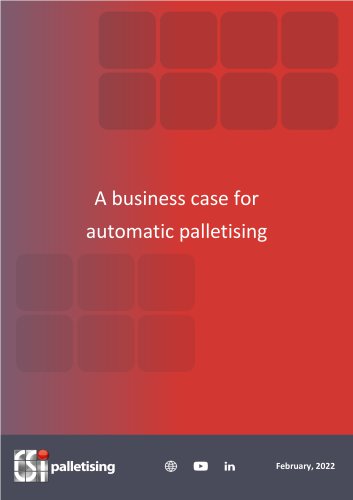
Catalog excerpts

Financing of Palletising equipment OPEX and CAPEX Remote service Providing service anytime, anywhere, Financing investments in anyway automatic palletising [Type here]
Open the catalog to page 1
Leasing has become a strong alternative to buying palletising equipment CONTENT Introduction Financial lease and leasing in general Operational lease Palletising as a service Buy and sell back A comparison Conclusion How can we help you? [Type here]
Open the catalog to page 2
Introduction As palletising equipment is considered as part of a production line, the generally accepted logic seems to be that you need to invest in this type of machinery. However, increased standardisation and the reduced time required for (de)installation have made it possible to rent or lease palletising equipment. By doing so, flexibility is created, together with taking advantage of several other benefits. In this white paper, we describe the pros and cons of alternative trajectories to simply buying palletising equipment. [Type here]
Open the catalog to page 3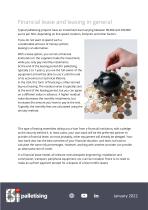
Financial lease and leasing in general Typical palletising projects have an investment level varying between 80,000 and 200,000 euros per SKU, depending on line speed, location, footprint and other factors. If you do not want to spend such a considerable amount of money upfront, leasing is an alternative. With a lease option, you can let a financial institution (or the supplier) make the investment, while you only pay monthly instalments. At the end of the leasing period (for palletising, typically 5 to 7 years), you are the full owner of the equipment and will be able to use it until the...
Open the catalog to page 4
Operational lease If you want a more flexible leasing option, an operational lease (or vendor lease) is an alternative. The basic form of operational lease has a model that is comparable with a financial lease; however, there are three important differences: 1. You are the user, not the owner; 2. There is more flexibility regarding leasing periods and residual values (and therefore monthly fees); 3. An operational lease is only applicable for those parts of the equipment that can be reused. Operational leasing of palletising systems does not cover bespoke conveyors or services such as...
Open the catalog to page 5
Palletising as a Service (PaaS) When ultimate flexibility is required, you can subscribe to the use of a palletiser. The machine will be delivered, installed and commissioned by the supplier. The only two things that you have to do are to use it and to pay the (monthly) fees. The supplier takes care of maintenance, repairs, spare parts and routine inspections. The subscriber buys the right to use the equipment for a variable period of time. This model is also termed a full operational lease/rental, and payments can be scheduled monthly or quarterly. Alternatively, it can be based on volume...
Open the catalog to page 6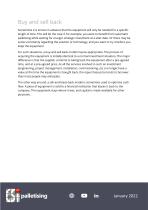
Buy and sell back Sometimes it is known in advance that the equipment will only be needed for a specific length of time. This will be the case if, for example, you want to benefit from automatic palletising while waiting for a larger strategic investment at a later date. Or there may be some uncertainty regarding the solution or technology, and you want to try it before you keep the equipment. For such situations, a buy-and-sell-back model may be appropriate. The process of acquiring the equipment is initially identical to a normal investment situation. The major difference is that the...
Open the catalog to page 7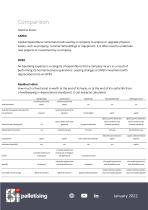
Comparison Good to know: CAPEX Capital expenditure comprises funds used by a company to acquire or upgrade physical assets, such as property, commercial buildings or equipment. It is often used to undertake new projects or investment by a company. OPEX An operating expense is a category of expenditure that a company incurs as a result of performing its normal business operations. Leasing changes a CAPEX investment (with depreciation) into an OPEX. Residual value How much a fixed asset is worth at the end of its lease, or at the end of its useful life from a bookkeeping (= depreciation)...
Open the catalog to page 8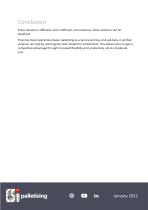
Conclusion Every situation is different, and in different circumstances, other solutions can be beneficial. Financial, basic operational lease, palletising as a service and buy-and-sell-back, in all their variants, can help by reducing the cash needed for investments. This allows users to gain a competitive advantage through increased flexibility and productivity, all at a moderate cost. [Type here]
Open the catalog to page 9
How can we help you? CSi already has 15 years of experience with financing models around palletising equipment. Based on this history, CSi is fully able to analyse your situation and advise you on the best way forward regarding these financing options. CSi is not tied to a bank or financial institution and can therefore offer independent advice. If you would like to receive more information, do not hesitate to contact us. CSi industries B.V. Lissenveld 41 4941 VL Raamsdonksveer The Netherlands Tel. +31 162 575 000 or info@CSiportal.com [Type here]
Open the catalog to page 10All CSi industries BV catalogs and technical brochures
-
Remote service
9 Pages
-
AGV versus AMR
6 Pages
-
Sustainability
1 Pages



